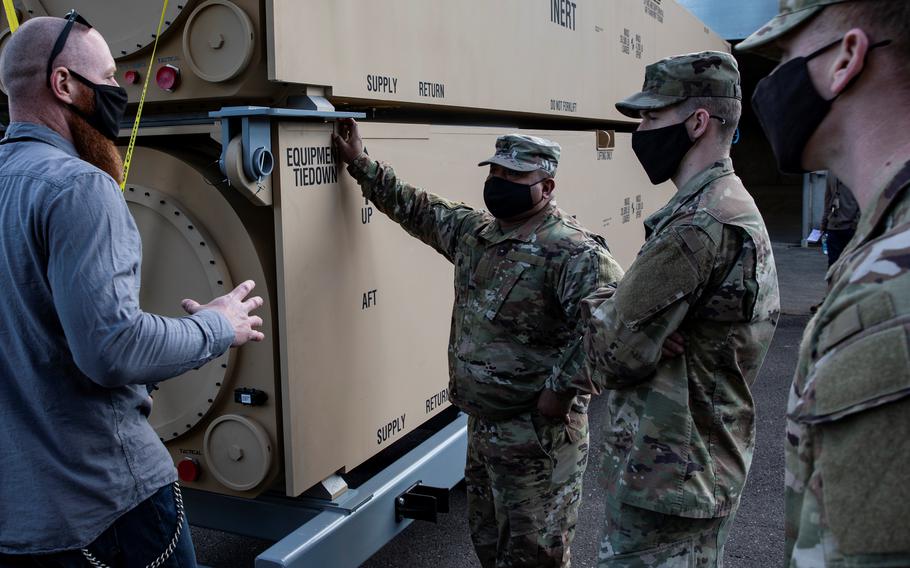
In March 2021, the U.S. Army began delivering the first prototype hypersonic equipment to soldiers with the arrival of two training canisters. Hypersonic weapons, capable of flying at speeds greater than five times the speed of sound (Mach 5+), are a new capability that provide a unique combination of speed, maneuverability and altitude to defeat time-critical, heavily-defended and high value targets. (Elliot Valdez)
Hypersonic weapons that can fly five times the speed of sound will add $21.5 billion to the Navy’s budget and $7 billion to the Army’s in coming years, according to an estimate compiled by the Pentagon’s independent cost assessment office.
It’s the first authoritative evaluation of how much the services may spend to develop and build the agile and speedy new missiles that can fly low and evade radar and missile defenses. Based on internal Defense Department estimates on the number of weapons planned, that amounts to about $106 million per missile for the Army and $89.6 million for the Navy.
Global competition to develop hypersonics was underscored by China’s reported test of two such weapons over the summer, including the launch into space of an orbiting weapon capable of carrying a nuclear payload. Last year, China deployed its first hypersonic weapon, the DF-17, leaving the U.S. lagging in producing a class of weapons that Pentagon officials have seen since 2017 as giving China a perceived advantage.
The U.S.’s hypersonic weapons, which it says will be nonnuclear, are in the early product development phase, which is typically top-heavy with one-time costs before production processes are refined.
The Pentagon cost office estimates the Navy’s Conventional Prompt Strike program consists of $10.1 billion in development, $11 billion in production and $400 million for related military construction. The Army’s Long-Range Hypersonic Weapon program is estimated at $4.4 billion for development and $2.5 billion for production. The office’s internal assessment, made available to Bloomberg News, shows an expected total of 66 missiles for the Army, which includes 48 development models, and 240 missiles for the Navy.
The Navy is overseeing development of the booster rocket and separate glide body for its use and the Army’s. Lockheed Martin and Northrop Grumman are the top program contractors. Dynetics, a subsidiary of Leidos Holdings, is developing the glide body.
‘Bow wave’
The cost per missile — which includes ancillary equipment such as storage canisters — may produce sticker shock inside the Defense Department and in Congress. The Pentagon already faces what’s been called a “bow wave” of burgeoning costs for projects, from expanding the Navy to maintaining the F-35 jet to modernizing the land-air-sea triad of nuclear weapons.
The concern over the potential price tag was reflected by the Pentagon’s top official overseeing hypersonic development, Undersecretary for Research and Engineering Heidi Shyu, who said in October that “we need to figure out how to drive towards more affordable hypersonics.”
Asked to elaborate on her comment, Shyu invoked one-time costs in the early stages of building and developing prototypes for the new weapons as a consideration. In a statement, she cited the need to build out “our production environment,” such as Lockheed’s newly opened hypersonic system factory in Courtland, Ala.
“Our goal is to make hypersonic weapons at costs comparable to today’s traditional weapons when we compare weapons of similar size, weight and complexity,” she said.
Among the challenges, Shyu said, is developing new materials and processing to reduce the cost of thermal protection needed to shield hypersonic glide systems from excessive heat within Earth’s atmosphere.
The new cost projection, ordered up by Congress, is “in close alignment with the Army and Navy cost estimates for their respective programs,” Navy Lt. Cmdr. Tim Gorman, a Pentagon spokesman, said in a statement.
Gorman provided the cost office’s estimated totals for the Army and Navy programs but said that the Defense Department’s in-house estimates of the costs per missile won’t be released, because they are considered premature.
Projected timeline
The Navy plans to buy 40 development-model hypersonic systems through 2025, including four already funded plus seven this fiscal year, 11 in fiscal 2023, 10 in 2024 and eight in 2025. It would then acquire production models for deployment, starting with four in 2025, 14 in fiscal 2026 and 16 each in 2027 and 2028, with purchases continuing through 2040 toward the eventual total of 240, according to the internal Pentagon estimates.
The service intends to field its initial weapons on the DDG-1000 Zumwalt-class destroyer by 2025 and on the Virginia-class submarine by 2028, according to fiscal 2022 budget documents cited by the Congressional Research Service.
The Army plans to buy 48 development models and 18 production versions. The development models would include 12 in fiscal 2023 and 14 in fiscal 2024, according to the internal figures. The production models would be bought in fiscal 2025 and 2026.
The Army intends to field its first prototypes for testing in fiscal 2023 to I Corps’ 5th Battalion, 17th Field Artillery Brigade.